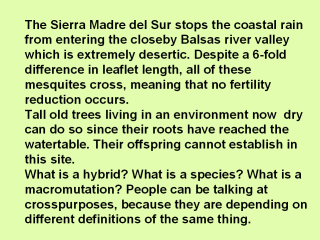 |
Progeny from populations that are
distinguishable with one or more heritable characters is a weak yet
sufficient definition of hybrid (Harrison, 1990) and used here. “Species are
groups of interbreeding natural populations which are reproductively
isolated from all other such groups” according to Mayr (1959). This is the
biological species concept and used here. Descent from an origin is
vertical, whereas mutation to create the same phenotype is horizontal. The
approaches of Stebbens (1950), Grant (1981) and Rieseberg (1997) to
hybridization are variously influenced by preDarwin Linnaean taxonomy which
is currently changing to evolutionary or phylogenetic classification,
emphasizing tree topologies. For discussion of macromutation, see
Charlesworth (1990). How often do adaptations involve the fixation of
macromutations? |
